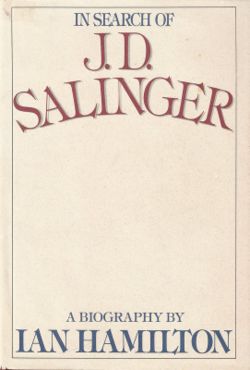MLA Citation:
Hamilton, Ian. In Search of J.D. Salinger: A Biography. New York: Random House, 1988. Print.
Dust Jacket Copy:
“In 1983 biographer Ian Hamilton began work on what he know would prove a formidable task: an account of the literary life of one of twentieth-century America’s most widely read and most reclusive writers, J.D. Salinger. What Hamilton didn’t know was that he would end up with not one story to tell but two, that his own life would ultimately become intimately entangled with that of his notoriously difficult subject.
Through The Catcher in the Rye and his timelessly provocative stories, Salinger’s magic has touched, and continues to touch, the lives of millions of readers. Yet the creator of Holden Caulfield and of the enigmatic Franny and Zooey is himself as much a mystery as even his most elusive characters. Now, in a brilliant feat of literary detection, the distinguished biographer Ian Hamilton penetrates the mystery, providing the first extended, responsible study of Jerome David Salinger, the writer and the man.
But In Search of J.D. Salinger is not merely the literary biography that Hamilton set out to write-the version that Salinger challenged in court. Ian Hamilton startling response has been to recast his book, telling the original story in fascinating detail, but also incorporating within it his own sometimes poignant, sometimes comic, sometimes exasperating quest for Salinger-a quest that has left him irrevocably a part of Salinger’s life, and Salinger a part of his.
Illuminating the roads he found into Salinger’s past-as well as describing the self-questioning process, the false starts, the shifts from certainty to doubt that occurred throughout the pursuit of his subject-Ian Hamilton takes us from Salinger’s New York City childhood and his adolescent years at Valley Forge military Academy to Salinger’s surprising military career; from close friendships and early influences to romances and a brief first marriage; from the days of writing for the ‘slicks’ to the first New Yorker successes; form Salinger’s reclusive obscurity to sudden and overwhelming fame-and his curious response to that fame. Finally, Hamilton recounts the legal confrontations of 1986 and 1987 that brought Salinger once again into the public world-if only briefly-and led Hamilton to retrace his own steps and retell his story, this time with himself as an essential player.
In Search of J.D. Salinger is a remarkable book in which a major biographer, critic, and poet has unearthed surprising quantities of information from sources other than Salinger himself, revealing what has never before been known about one of our most distinguished writers of fiction-and taking us along on his own turbulent journey in the process.”

